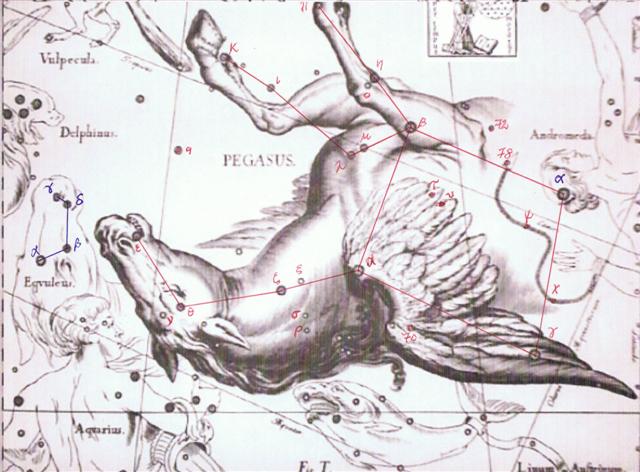In the Babylonian zodiac we can see the figure of the Great One about halfway from midwinter to the spring equinox:
He was standing on a Fish, and with his pointed headgear he 'pierced' the Swallow. Above was the Field, an inundated piece of earth. And the beginning of this Field was marked by the right foreleg the Horse. It is not difficult to interpret this scenario. The inundated earth (Field) corresponds to the Square of Pegasus, the winged horse:

In rongorongo times precession had moved the composition ahead in the year and it now rested at a position half a quarter later than in Babylonian times.
Sirrah (α Andromedae) together with Algenib (γ Pegasi) were defining the line where 'the dark cloth' of winter ended, where the fields of earth would begin to come alive again, rise again from the billows:
| March 21 |
|
22 (81) |
23 |
| September 20 |
21 |
equinox (265) |
| no glyph |
 |
 |
| Ca1-1 |
Ca1-2 |
| koia |
ki te hoea |
| Al Fargh al Thāni-25 |
Uttara Bhādrapadā-27 / Wall-14 |
χ Pegasi (2.1), θ Andromedae (2.7) |
| 0h (365.25) |
| Caph, SIRRAH (0.5), ε Phoenicis (0.8) |
ALGENIB PEGASI (1.8) |
| 1842 A.D. |
1771 A.D. |
1700 A.D. |
| 12h (182.6) |
Pálida (184.6), Megrez (184.9) |
Hasta-13 / Chariot-28 |
| Alchita, Ma Wei (183.1), Minkar (183.7), ρ Centauri (183.9) |
GIENAH (185.1), ε Muscae (185.2), ζ Crucis (185.4), Zaniah (185.9) |
| March 24 |
25 (84) |
| September 23 |
24 |
 |
 |
| Ca1-3 |
Ca1-4 |
| ki te henua |
te rima te hau tea |
| ζ Tucanae (3.5), π Tucanae (3.7) |
no star listed |
| 1629 A.D. |
1558 A.D. |
| Chang Sha (186.3) |
Intrometida (187.4), Acrux (187.5) |
| March 26 |
27 |
28 |
29 (88) |
| September 25 (268) |
26 |
27 |
28 |
 |
 |
 |
 |
| Ca1-5 |
Ca1-6 |
Ca1-7 |
Ca1-8 |
| haga i te mea ke |
ki te henua -
tagata honui |
te ika |
te honu |
| Ankaa, κ Phoenicis (5.0) |
λ Phoenicis (6.3),
β Tucanae (6.4) |
no star listed |
DELTA
(8.4), Schedir (8.6), μ Phoenicis (8.9) |
| 1487 A.D. |
1416 A.D. |
1345 A.D. |
1274 A.D. |
|
γ Com. Berenicis (188.0), σ Centauri (188.1), Algorab (188.5), Gacrux (188.7)
Alphard
|
γ Muscae (189.0), Avis Satyra
(189.3), Asterion (189.5), Kraz (189.7) |
α Muscae (190.2), τ Centauri (190.5), χ
Virginis (190.7) |
Al Áwwā'-11 |
|
ρ Virginis (191.4),
PORRIMA, γ Centauri (191.5) |
The Fish on which the Great One was standing would be difficult to depict in such a postion in rongorongo texts - it would be too crowded in the glyph line. Therefore, I suggest, this Fish (te ika) was placed side by side and after (instead of below).
| Ika 1. Fish. 2. In some cases, animal in general: îka ariga koreh[v?]a, animal with the face of a koreva fish (name given to horses when they arrived on the island, because of the resemblance of their heads with that of a koreva). 3. Victim (wounded or killed), enemy who must be killed, person cursed by a timo and destined to die; îka reirei, vanquished enemy, who is kicked (rei). 4. Corpse of man fallen in war. Vanaga.
1. Fish, animal; ika rere, flying fish; ivi ika, fishbone; mata ika, pearl. P Pau., Mgv., Mq.: ika, fish. Ta.: ia, id. 2. Prey, victim, sacrifice; ika ke avai mo, abuse; hakarere ki te ika, to avenge. T Mgv.: ikaiara, to quarrel; ikatamamea, to be angry because another has handled one's property. Mq.: ika, enemy, what causes horror. Ma.: ika, the first person killed in a fight. Mangaia: ika, a victim for sacrifice. 3? matamata ika, snow. Ikahi, to fish with a line, to angle. Mq.: ikahi, id. Ikakato, to go fishing. Ikakohau, to fish with a line, to angle. Ikapotu, cape, end of a voyage, destination; ikapotu hakarere, to abut, to adjoin; topa te ikapotu, id.; tehe oho te ikapotu, id.; mei nei tehe i oho mai ai inei te ikapotu, as far as, to. Ikapuhi, to fish with a torch. Mq.: ikapuhi, id. Churchill. |
Late winter rains would have been the Sign for Mother Earth to return to life from a state of inert dormancy (moe), resting in peace:

Maybe Ca1-5 described the stage when all still was covered up.
 |
 |
| puo |
Ca1-5 |
| Puo (Also pu'a); pu'o nua, one who covers himself with a nua (blanket), that is to say, a human being. Vanaga.
1. To dress, to clothe, to dress the hair; puoa, clothed; puoa tahaga, always dressed. 2. To daub, to besmear (cf. pua 2); puo ei oone, to daub with dirt, to smear. 3. Ata puo, to hill up a plant. Churchill. |
|







